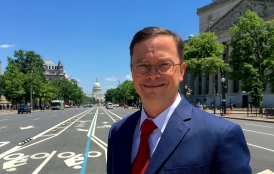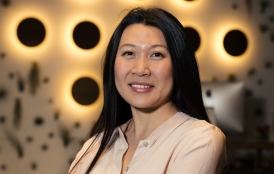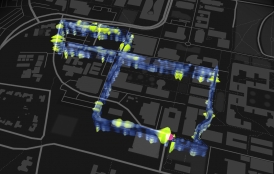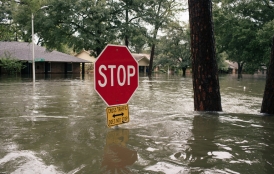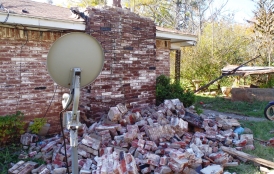The Stanford School of Earth, Energy & Environmental Sciences is now part of the Stanford Doerr School of Sustainability.
This page is currently being maintained for archival purposes only. For the latest information, please visit us here.
The equation that keeps on giving
Jenny Suckale is endlessly fascinated by the Navier-Stokes equation, which she uses to study everything from volcanic eruptions to Antarctic ice flow. The story of how Suckale came to discover and love the Earth Sciences is as nonlinear as some of the natural phenomena she studies.
By
Ker Than
Stanford School Of Earth Sciences
November 11, 2014
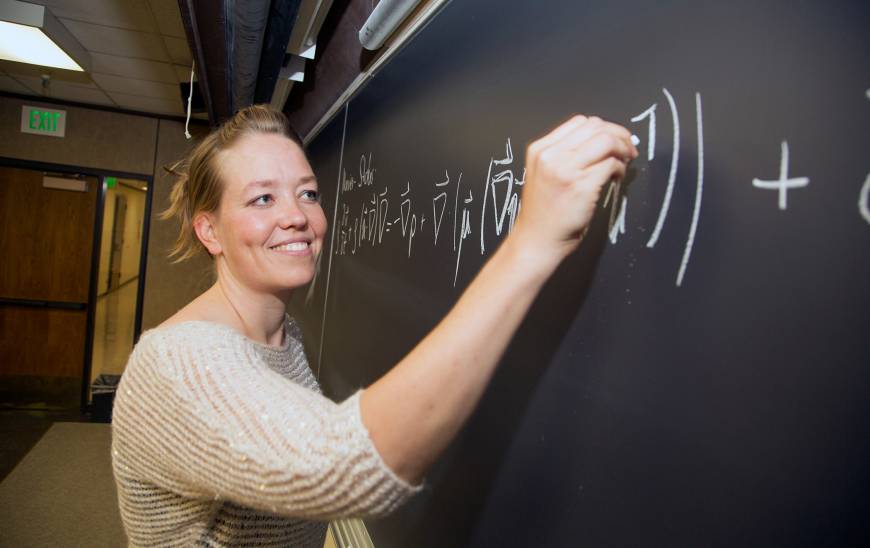
Jenny Suckale writes down the equation that has defined her scientific career. Credit: Stacy Geiken
Jenny Suckale scribbles the math equation that underpins her scientific career onto the chalkboard. "That's it," she said, taking a step back. "That's the whole equation."
Formulated in the 19th century by European physicists Claude-Louis Navier and George Gabriel Stokes, the Navier-Stokes equation describes the motion of fluid substances, and it is a source of endless fascination for Suckale, an assistant professor of geophysics who joined Stanford's School of Earth Sciences in January from Harvard, where she was a postdoctoral researcher.
"There's a lot of subtle complexity to this equation," Suckale said. "It describes pretty much everything that flows. It describes why planes fly, why fish can swim, why volcanoes erupt, why tsunamis charge up onto shore. It describes sand storms in Africa, and ice motion in Antarctica."
Remarkably, Suckale doesn't even utilize the entire Navier-Stokes equation in her research. Rather, she's focused on a subset, or "term," made up of just three symbols. "My life revolves around this term," she said. "It encapsulates so much subtlety in the behavior of fluids that you can spend forever and ever studying it. The way I think of it is like a tree. This is basically the root, but the branches that can develop from it are unlimited."
While a graduate student at MIT, Suckale used the Navier-Stokes equation to develop an alternative theory for what is driving the near constant eruption of Italy's Stromboli volcano. "The conventional wisdom was that giant gas bubbles were driving the eruptions, but we showed that's unlikely because the bubbles aren't compatible with the basic laws of fluid dynamics," Suckale said.
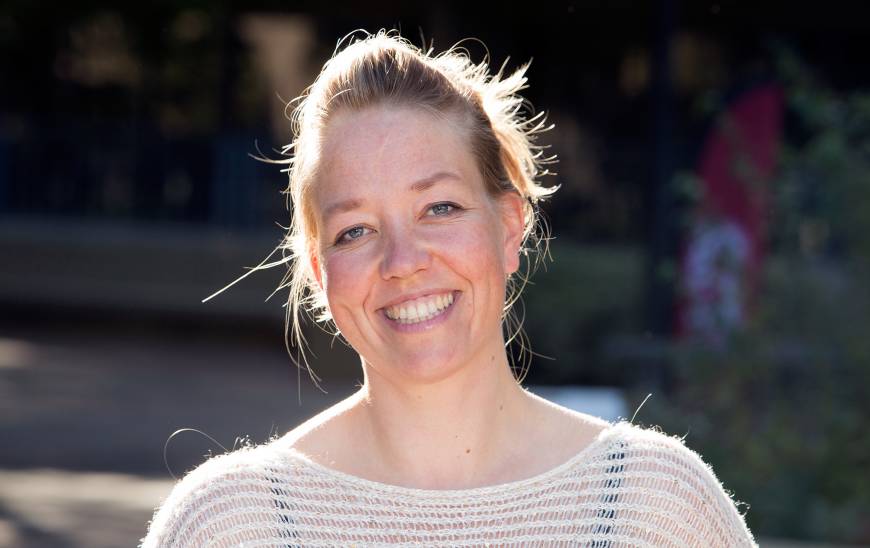
Credit: Stacy Geiken
Antarctica’s bleeding heart
Suckale is currently using the equation to attempt to explain puzzling satellite imagery that show Antarctica is melting from the inside out. "Ice from the continent's interior form streams that flow out to sea," Suckale said. "These ice streams are almost like arteries that help transport ice from the center of Antarctica to the coast very rapidly. It's like a bleeding heart in some sense."
Explaining the dynamics of that bleeding heart could have implications for climate change computer models. Ice melt is currently one of the biggest uncertainties in climate simulations, and Antarctica is the single largest mass of ice on Earth. Suckale hypothesizes that Antarctica's melting can be explained by the way that ice inside the margins of the ice stream is heating up and turning into water. This water trickles, drop by drop and via countless wandering tunnels in the ice, down to lower layers, where it forms a slick foundation on which the overlying ice stream moves. In other words, the answer might once again come down to fluid flow, and thus a problem that is within the scope of the Navier-Stokes equation.
"We think it definitely has to do with our term in the equation, and one symbol in particular. It looks like a very innocent symbol, but it's not innocent," she said.
Making theory count
Suckale's own career path is as meandering as the movements of the water droplets that she thinks are key to deciphering Antarctica's melting behavior. At Germany's Free University of Berlin, where she was an undergrad, she studied physics, with an emphasis on quantum field theory. She remembers that even then, she yearned to study something more practical. "The theories we were developing were so far from experiments that they wouldn't be tested for decades," Suckale said. "To me, the beauty of theory is to make it count."
So when her boss at UNESCO, where she was working at an office job while a student, told her about a job opportunity as a scientific consultant, she leapt at the chance. "UNESCO was looking for someone to create earthquake models and calculate earthquake statistics," she said.
After a few years of working for the United Nations, mostly in the South Pacific in places such as Fiji and Vanuatu, Suckale attended Harvard University's Kennedy School of Government, where she received a Master of Public Administration. The decision was driven in part by a desire to better utilize her scientific skillset for humanitarian work. "I felt like I enjoyed my work for the United Nations, but I didn't think it was a good use of my skills and interests. I studied physics because I felt like it opened up a whole new horizon about how to think about the world and all these different complex systems. But in the UN, I couldn't make that count, or turn it into anything real. To me, that was the whole point," she said. "So I went to the Kennedy School because I felt like I need to understand why that was."
"I think the Earth sciences just have way cooler problems than anything I've personally encountered in classical physics. It's tangible, it's real, it's important, it's fascinating, it's dramatic, and it’s colorful."
A place for science in humanitarian work
Suckale said her graduate school experience reaffirmed her belief that there was a place for science in humanitarian aid, and it taught her to better identify those problems where her scientific perspective was particularly valuable. She cited one recent example: "After the 2011 Tohoku tsunami, a friend who was working with a Japanese coastal community that had been hit really badly because the waves disintegrated their seawall called me. They were debating whether they wanted to rebuild the wall or grow a coastal forest that could serve as a 'bio-shield' against the waves," Suckale said.
Bio-shields have been promoted as a solution to everything from tsunamis to storm surges in many places around the world, but the more Suckale looked into it, the more she realized that there were still many unknowns about the approach. "We know very little about how vegetation changes affect a tsunami wave. Does it change the wave height? Or its flow speed? Does it dissipate the wave's energy? We didn't know any of that. But those are science questions. That's in our ballpark and nobody else's," she said.
 Tsunami hitting Natori City, Japan, March 11, 2011. Credit: Reuters/Kyoto
Tsunami hitting Natori City, Japan, March 11, 2011. Credit: Reuters/Kyoto
Suckale said it was her love of science that ultimately led to her return to academia. "I realized that if you’re part of the UN, you will always be primarily a politician. That's just the nature of the organization. I'm not a politician. Deep down I'm a physicist," she said.
By that time, she had also developed a strong interest in the Earth Sciences because of her work on hazards mitigation for the UN. "After that, I was hooked on the Earth sciences big time. I think the Earth sciences just have way cooler problems than anything I've personally encountered in classical physics. It's tangible, it's real, it's important, it's fascinating, it's dramatic, and it’s colorful," she said.
This realization led her to pursue a PhD in geophysics at MIT. Suckale said she chose to come to the Stanford School of Earth Sciences upon completion of her degree in part because she felt genuinely welcomed here. "I felt like the School was really excited to have me. I felt that Stanford liked my math-y side as well as my geo side,” Suckale said, “and that was exciting.”
Suckale was also impressed by the university’s commitment to computing. The School of Earth Sciences has long supported a Center for Computational Earth and Environmental Sciences (CEES) and the university recently invested in a campus-wide Stanford Research Computing Center (SRCC). "I love the fact that there's hard-core computing here, because I think the answers to many of the problems we're addressing lies in computing," she said. "Stanford shines in that area pretty much like no other."
Suckale said she is eager to apply those computing resources to tackling the complex and to her, captivating, physics equations found in the geosciences–including her favorite term in her favorite equation. "I love the applied side of geoscience research, but even if that weren’t true, I would still want to work in this field because the physics is just beautiful, way more so to me than quantum field theory ever was," she said.
"The beauty of equations like the Navier-Stokes equation is that it's simple. It's so simple that you can't argue with it. It has to be true."
Ker Than is associate director of communications for the School of Earth Sciences.




